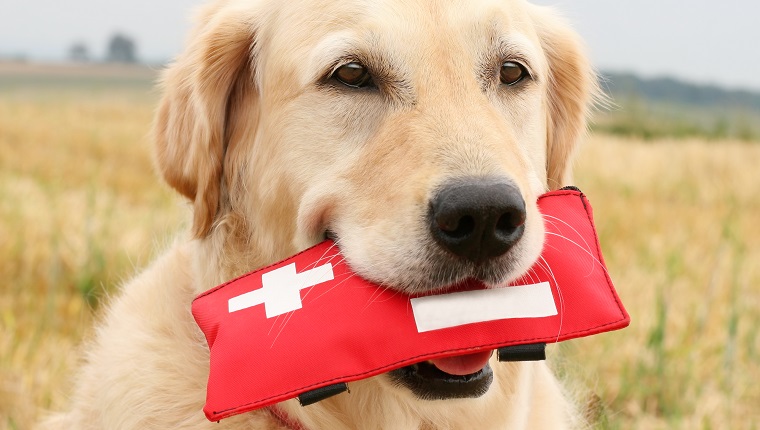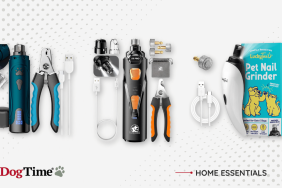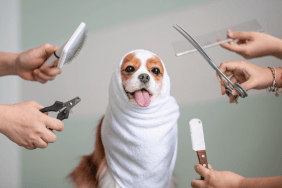April is National Pet First Aid Awareness Month, and it’s a perfect time to go over exactly what you should include in your dog’s first-aid kit. Even if you already have a first-aid kit, now might be a good time to make sure the supplies haven’t expired or run out.
You never know what’ll happen when it comes to accidents and emergencies, so it’s good to be prepared. When you’re camping, driving across the country, or facing a natural disaster, you need to be ready.
Just like you have a first-aid kit for the humans in your home, it’s important to keep one handy for the canines in your life.
It’s best to put all of your doggy first-aid supplies in a bag, bin, backpack, shoulder bag, or container. That way it can travel with you and your dog when you’re taking road trips, camping, or hiking. You’ll want to make it easy to pick up and take out to the yard or wherever your dog might need treatment.
Of course, it’s always best to seek professional veterinary treatment when your dog gets hurt. However, you may find yourself in a situation where you can’t get to a vet, or you may need to care for your dog until you can get them to the emergency room.
In those moments, you’ll be glad you have a first-aid kit handy.
Here are a few essential items you should always keep in your dog’s first-aid kit.
1. Paperwork: Vaccination & medical records and emergency phone numbers
If you’re dealing with a critical emergency, you’ll want all of your dog’s info in one place. This will help if your dog gets hurt and needs medical attention.
If you can get to the emergency vet, they’ll be able to provide better, safer care if they know your dog’s medical history. You’ll also want emergency numbers ready to go, even if you lose your phone where you usually have your contacts saved.
In the event of a disaster, you may not have electricity, internet, or phone service. Keep a hard copy of all of your dog’s paperwork with your emergency kit. A USB drive with your dog’s records saved is a good thing to have as a backup.
If you go out of town and leave your pup with a dog sitter or friend, make sure they know where the paperwork and contacts are in the event of an emergency.
2. Hydrogen peroxide
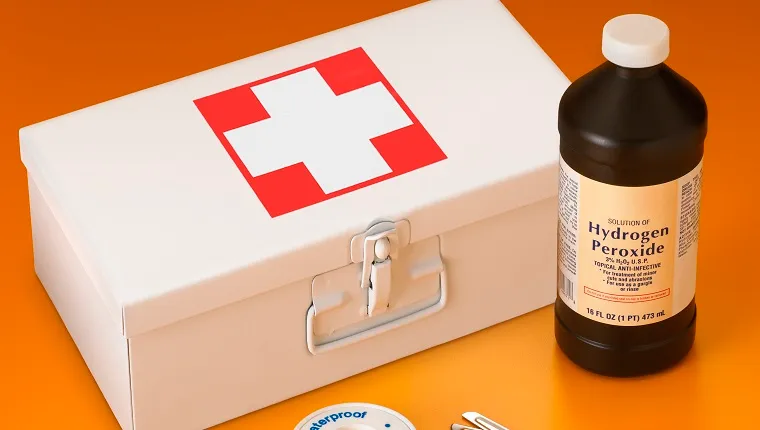
Hydrogen peroxide isn’t just for cleaning minor wounds. If your dog does ingest something toxic, you may have to induce vomiting with hydrogen peroxide.
Always check with a poison control professional or your vet before inducing vomiting, and familiarize yourself with the proper instructions on how to do this. During a crisis is not the time you want to learn how to do this kind of thing.
You should also print out the instructions. In the event of a natural disaster, you may not have electricity or internet service, so having a hard copy of something like this could be a lifesaver.
Again, do not attempt to administer this to your dog without professional guidance.
3. Antibiotic ointment
If you and your pup are the outdoorsy type, it is advisable to keep this type of item on you at all times.
If your pup gets a small cut or scratch, antibiotic ointments will help prevent infection, relieve pain, and act as a barrier from bacteria and germs. It’s something every first-aid kit should have.
Even minor cuts and scrapes can lead to a lot of major health problems if they become infected.
4. Gauze, scissors, tape, rubber gloves
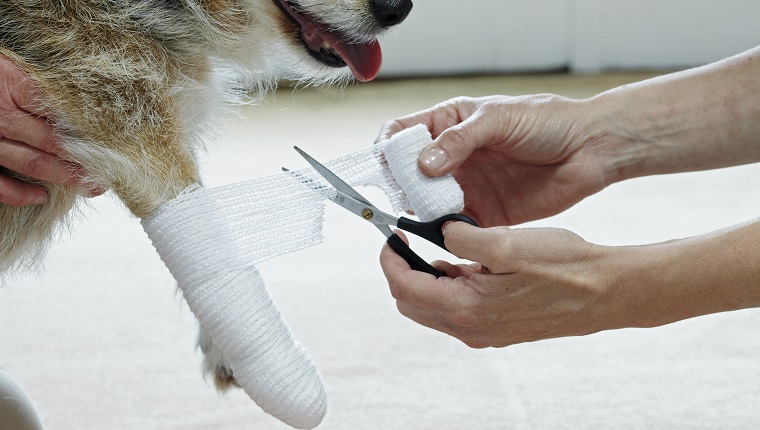
This may be more than one item, but they are a package deal in my opinion. They all work together when you need them.
In an emergency situation, gauze can control bleeding, act as a temporary brace for suspected fractures, and can even be a makeshift muzzle in a pinch.
Tape can hold gauze or other first-aid items in place, and scissors can cut an old shirt into strips to make a more solid bandage for larger wounds or to help if you run out of gauze.
Rubber gloves are essential to any medical emergency. Always wear protective gloves and, hopefully, goggles or glasses if you have them when you’re dealing with blood or bodily fluids.
5. Wet or grooming wipes
These may not seem like “emergency” material, but when your dog has a bathroom situation and decides to take care of business in the back seat of your car, these will help. These and a few towels.
Wipes are great for cleaning off muddy paws before getting in the car, for messy accidents, or for when your dog decides to roll around in some unknown patch of grass. You can also use them to clean dirt or blood off of a wound to get a better look, or to clean an eye or ear.
Fecal matter, dirt, and outdoor water sources can harbor lots of dangerous bacteria and parasites, so keeping your dog and their immediate environment clean will help prevent infections and infestations that could make your dog sick.
6. A towel or blanket
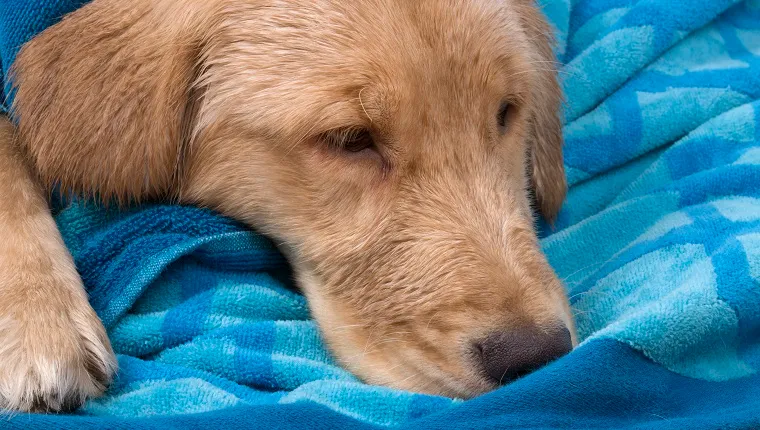
If your dog is injured or panicking, gently wrapping them up in a soft blanket can help calm them down and allow you to access their injury without being scratched or bitten.
Microfiber is ultra absorbent and can help in sticky situations. Literally.
A towel or blanket will also offer a soft surface for you to rest your dog for an examination if the ground is too hot, hard, or covered in sharp rocks and you need to get a better look at what’s going on.
7. Collapsible travel food & water bowls
These are great in emergency and non-emergency situations alike. Long hikes, cross-country road trips, or anytime you are away from home, you should have at least one collapsible bowl with you, or something to give your dog water.
Hydration is vitally important for all living things. Be sure to offer your dog lots of water, even if you’re just out running errands for the afternoon.
Try to stick with silicone, not plastic, as plastic can easily break into sharp pieces or start to leach into your dog’s food and water.
8. Water & small packages of food or treats

It seems like these things should go without saying, but sometimes the most obvious things are the ones we forget.
Be sure to keep a bottle of water for your dog in case you don’t have access to your normal supply, and keep an emergency stash of food in case of shortage or to help distract your dog in an emergency. Or you can just reward them for their bravery after they’ve allowed you to remove a thorn or tick.
Again, avoid plastic when you’re deciding which water bottles to pack.
9. Medications
Talk to your vet about keeping a backup supply of any prescribed or useful medications in your first-aid kit.
If you’re traveling and lose or can’t find the medication, you’ll always have a backup supply so you don’t have to panic or spend a day having your vet call in a prescription across the country.
It’s never a bad idea to have a few vet-approved, over-the-counter medicines handy, especially if you are traveling. This includes flea and tick meds, antacids or drugs for stomach issues, and any approved sedatives for traveling.
Always check to make sure these medicines haven’t expired.
10. A comfort item

If you’re in a high stress situation with your dog, such as a nasty storm or a particularly traumatizing event, it’s always nice to have a creature comfort to soothe them.
Keep an old favorite toy or blanket that you were thinking of retiring and put it in the first-aid kit. The sight and smell of a beloved object can help settle them down, soothe, and comfort in particularly trying situations.
11. Extra Leash, Collar, & Poop Bags
If your dog gets sick, they may go through more poop bags than you can imagine. Be sure to have an extra supply on hand.
It’s never a bad idea to have an extra collar and leash around. I’ve seen dogs snap leashes in accidents, and they are very useful if you happen upon a lost or stray animal out on the highway or in the mountains and want to get them to the local vet or nearest town.
Those free leashes or collars the vet sends home with you sometimes are perfect for your emergency kit or just to keep in your car in the event of an emergency.
Again, you can recycle supplies for your first-aid kit. Old dog leashes or collars that you’re about to replace would make an easy addition to your kit, and you don’t need to spend more money.
12. Flashlight
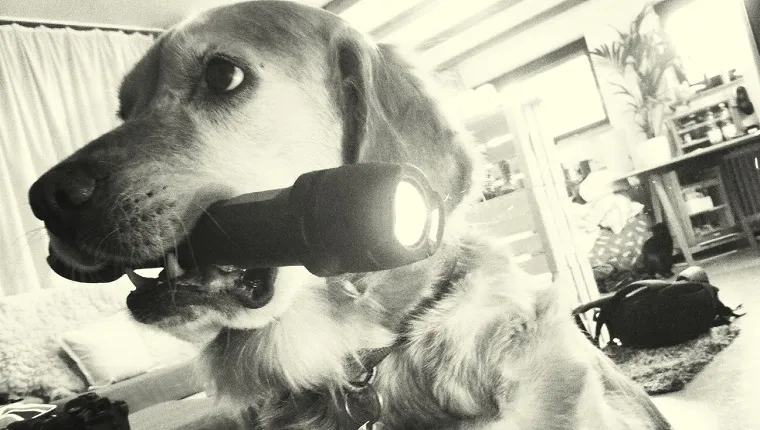
You always want to keep a flashlight around, not just for the night time. You may just need to get more light to pull out a splinter or find a pill you dropped.
Flashlights can also be helpful for scaring off wildlife, like coyotes, if they’re endangering you or your dog.
Extra batteries are important, too, and you may want to consider solar powered flashlights. They’re perfect for emergencies and charge up in the light for when you need them in the dark. Just make sure you store it in a place where it will get plenty of light to stay charged up. I keep mine hanging in the kitchen window so they are always ready to go.
13. A guide book for pet first aid

Answer quickly: how do you administer CPR to a small dog?
If you panicked at the idea of even attempting CPR on a dog, maybe you should brush up your skills.
The Safe Dog Handbook would be a great place to start. You should keep a guide handy for quick reference, as well. If there’s an emergency and Google isn’t an option, you’ll be glad you have a hard copy.
What would you include in your doggy first-aid kit? Are there any essentials we missed?
